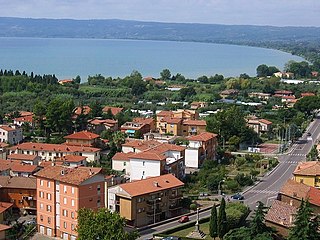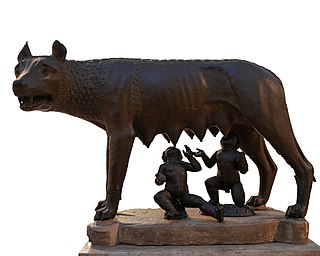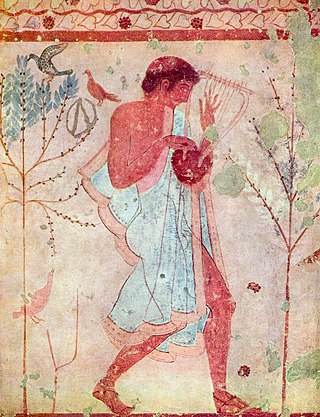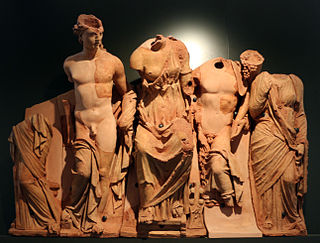Related Research Articles

Veii was an important ancient Etruscan city situated on the southern limits of Etruria and 16 km (9.9 mi) north-northwest of Rome, Italy. It now lies in Isola Farnese, in the comune of Rome. Many other sites associated with and in the city-state of Veii are in Formello, immediately to the north. Formello is named after the drainage channels that were first created by the Veians.
Marcus Furius Camillus is a semi-legendary Roman statesman and politician during the early Roman republic who is most famous for his capture of Veii and defence of Rome from Gallic sack after the Battle of the Allia. Modern scholars are dubious of Camillus' supposed exploits and believe many of them are wrongly attributed or otherwise wholly fictitious.

Falerii is a village in the municipality of Fabrica di Roma in the Province of Viterbo, Italy. Its name is better known for two nearby ancient cities, Falerii Veteres and Falerii Novi.

Ancient art refers to the many types of art produced by the advanced cultures of ancient societies with different forms of writing, such as those of ancient China, India, Mesopotamia, Persia, Palestine, Egypt, Greece, and Rome. The art of pre-literate societies is normally referred to as prehistoric art and is not covered here. Although some pre-Columbian cultures developed writing during the centuries before the arrival of Europeans, on grounds of dating these are covered at pre-Columbian art and articles such as Maya art, Aztec art, and Olmec art.

Volterra is a walled mountaintop town in the Tuscany region of Italy. Its history dates from before the 8th century BC and it has substantial structures from the Etruscan, Roman, and Medieval periods.

Volsinii or Vulsinii, is the name of two ancient cities of Etruria, one situated on the shore of Lacus Volsiniensis, and the other on the Via Clodia, between Clusium (Chiusi) and Forum Cassii (Vetralla). The latter was Etruscan and was destroyed by the Romans in 264 BC following an attempted revolt by its slaves, while the former was founded by the Romans using the remainder of the Etruscan population rescued from the razed city.

The Battle of the Allia was a battle fought c. 387 BC between the Senones – a Gallic tribe led by Brennus, who had invaded Northern Italy – and the Roman Republic.

The Temple of Jupiter Optimus Maximus, also known as the Temple of Jupiter Capitolinus was the most important temple in Ancient Rome, located on the Capitoline Hill. It was surrounded by the Area Capitolina, a precinct where numerous shrines, altars, statues and victory trophies were displayed.


The Capitoline Wolf is a bronze sculpture depicting a scene from the legend of the founding of Rome. The sculpture shows a she-wolf suckling the mythical twin founders of Rome, Romulus and Remus. According to the legend, when King Numitor, grandfather of the twins, was overthrown by his brother Amulius in Alba Longa, the usurper ordered them to be cast into the Tiber River. They were rescued by a she-wolf that cared for them until a herdsman, Faustulus, found and raised them.

The Tomb of the Roaring Lions is an archaeological site at the ancient city of Veii, Italy. It is best known for its well-preserved fresco paintings of four feline-like creatures, believed by archaeologists to depict lions. The tomb is believed to be one of the oldest painted tombs in the western Mediterranean, dating back to 690 BCE. The discovery of the Tomb allowed archaeologists a greater insight into funerary practices amongst the Etruscan people, while providing insight into art movements around this period of time. The fresco paintings on the wall of the tomb are a product of advances in trade that allowed artists in Veii to be exposed to art making practices and styles of drawing originating from different cultures, in particular geometric art movements in Greece. The lions were originally assumed to be caricatures of lions – created by artists who had most likely never seen the real animal in flesh before.

Lars Tolumnius was the most famous king of the wealthy Etruscan city-state of Veii. He is best remembered for instigating, and decisively losing, a war with the neighboring Roman Republic.

The Apollo of Veii is a life-size painted terracotta Etruscan statue of Aplu (Apollo), designed to be placed at the highest part of a temple. The statue was discovered in the Portonaccio sanctuary of ancient Veii, Latium, in what is now central Italy, and dates from c. 510 - 500 BC. It was created in the so-called "international" Ionic or late-archaic Etruscan style.

Romulus was the legendary founder and first king of Rome. Various traditions attribute the establishment of many of Rome's oldest legal, political, religious, and social institutions to Romulus and his contemporaries. Although many of these traditions incorporate elements of folklore, and it is not clear to what extent a historical figure underlies the mythical Romulus, the events and institutions ascribed to him were central to the myths surrounding Rome's origins and cultural traditions.

Etruscan art was produced by the Etruscan civilization in central Italy between the 10th and 1st centuries BC. From around 750 BC it was heavily influenced by Greek art, which was imported by the Etruscans, but always retained distinct characteristics. Particularly strong in this tradition were figurative sculpture in terracotta, wall-painting and metalworking especially in bronze. Jewellery and engraved gems of high quality were produced.

Alba Longa was an ancient Latin city in Central Italy in the vicinity of Lake Albano in the Alban Hills. The ancient Romans believed it to be the founder and head of the Latin League, before it was destroyed by the Roman Kingdom around the middle of the 7th century BC and its inhabitants were forced to settle in Rome. In legend, Romulus and Remus, founders of Rome, had come from the royal dynasty of Alba Longa, which in Virgil's Aeneid had been the bloodline of Aeneas, a son of Venus.
The Roman–Etruscan Wars, also known as the Etruscan Wars or the Etruscan–Roman Wars, were a series of wars fought between ancient Rome and the Etruscans. Information about many of the wars is limited, particularly those in the early parts of Rome's history, and in large part is known from ancient texts alone. The conquest of Etruria was completed in 265–264 BC.

Etruscan architecture was created between about 900 BC and 27 BC, when the expanding civilization of ancient Rome finally absorbed Etruscan civilization. The Etruscans were considerable builders in stone, wood and other materials of temples, houses, tombs and city walls, as well as bridges and roads. The only structures remaining in quantity in anything like their original condition are tombs and walls, but through archaeology and other sources we have a good deal of information on what once existed.

Roman Republican art is the artistic production that took place in Roman territory during the period of the Republic, conventionally from 509 BC to 27 BC.

Etruscan sculpture was one of the most important artistic expressions of the Etruscan people, who inhabited the regions of Northern Italy and Central Italy between about the 9th century BC and the 1st century BC. Etruscan art was largely a derivation of Greek art, although developed with many characteristics of its own. Given the almost total lack of Etruscan written documents, a problem compounded by the paucity of information on their language—still largely undeciphered—it is in their art that the keys to the reconstruction of their history are to be found, although Greek and Roman chronicles are also of great help. Like its culture in general, Etruscan sculpture has many obscure aspects for scholars, being the subject of controversy and forcing them to propose their interpretations always tentatively, but the consensus is that it was part of the most important and original legacy of Italian art and even contributed significantly to the initial formation of the artistic traditions of ancient Rome. The view of Etruscan sculpture as a homogeneous whole is erroneous, there being important variations, both regional and temporal.
References
- ↑ Jerome Jordan Pollitt (12 May 1983). The Art of Rome C.753 B.C.-A.D. 337: Sources and Documents. Cambridge University Press. pp. 8–. ISBN 978-0-521-27365-7.
- ↑ Steven L. Tuck (16 December 2014). A History of Roman Art. Wiley. pp. 1–. ISBN 978-1-118-88543-7.
- ↑ Gardner, Helen; Fred S. Kleiner; Christin J. Mamiya (2004). Gardner's Art through the Ages. Thompson Wadsworth. p. 236. ISBN 0-534-64095-8.
